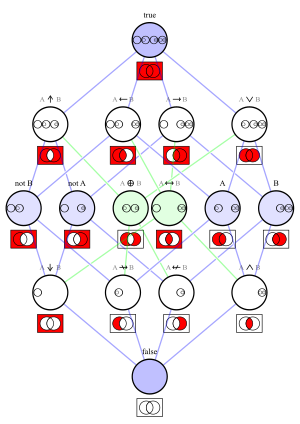
Back رابطة منطقية Arabic Məntiqi əməliyyat Azerbaijani Логическа операция Bulgarian Connectiva lògica Catalan Logisk konnektiv Danish Logische Verknüpfung German Λογικές συναρτήσεις Greek Conetîv lògic EML Conectiva lógica Spanish Konnektor (keeleteadus) Estonian
| Logical connectives | ||||||||||||||||||||||
|---|---|---|---|---|---|---|---|---|---|---|---|---|---|---|---|---|---|---|---|---|---|---|
|
||||||||||||||||||||||
| Related concepts | ||||||||||||||||||||||
| Applications | ||||||||||||||||||||||
|
| ||||||||||||||||||||||

In logic, a logical connective (also called a logical operator, sentential connective, or sentential operator) is a logical constant. Connectives can be used to connect logical formulas. For instance in the syntax of propositional logic, the binary connective can be used to join the two atomic formulas and , rendering the complex formula .
Common connectives include negation, disjunction, conjunction, implication, and equivalence. In standard systems of classical logic, these connectives are interpreted as truth functions, though they receive a variety of alternative interpretations in nonclassical logics. Their classical interpretations are similar to the meanings of natural language expressions such as English "not", "or", "and", and "if", but not identical. Discrepancies between natural language connectives and those of classical logic have motivated nonclassical approaches to natural language meaning as well as approaches which pair a classical compositional semantics with a robust pragmatics.
A logical connective is similar to, but not equivalent to, a syntax commonly used in programming languages called a conditional operator.[1][better source needed]
- ^ Cogwheel. "What is the difference between logical and conditional /operator/". Stack Overflow. Retrieved 9 April 2015.
© MMXXIII Rich X Search. We shall prevail. All rights reserved. Rich X Search





































